The working environment is growing ever more volatile and uncertain. It asks a lot of us as leaders.
The recent shift to an extended period of remote work has required leaders to flex their leadership styles to fit new ways of working.
Some of us have made deliberate shifts, while others have just done the best they can during these challenging times.
Leadership theories offer an academic perspective on the many different leadership styles.
In this article, we’ll explore some common theories, help you decide which approach might be right for you, and show you how to put them into practice.
What are leadership theories?
Leadership theories are academic models and schools of thought that present an opinion on what makes someone a leader.
These theories examine the characteristics and behaviors of leaders and offer thoughts on when and where those characteristics and behaviors would be effective.
Others can then study these models to inform their leadership style and increase leadership capability.
Despite them often being used interchangeably, leadership is different from management.
Management focuses more on successful team operations and processes. Leadership is about building motivation and momentum in others to follow your vision for the future.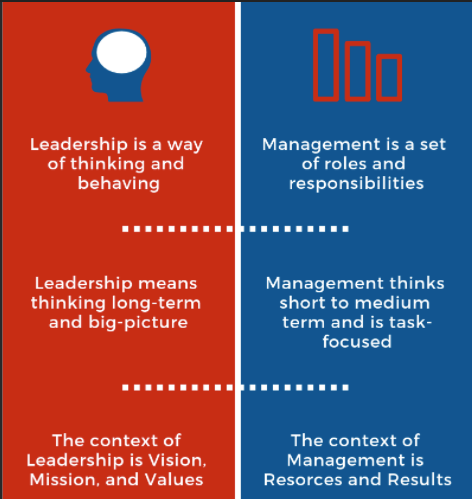
Why is understanding leadership theories important?
Understanding leadership theories is essential for improving leadership skills. Most of us have a preference for the way we lead others. This comes from training, experience, or observing others we admire.
For new leaders — or those experiencing a new working environment or culture — reading about leadership theories can be the first step toward identifying the type of leader you want to be.
For more experienced leaders, exploring alternative theories can help to show that their preferred leadership style may not work in all circumstances.
Understanding alternative characteristics and behaviors that are more effective in certain circumstances can help leaders flex their style should their working environment change.
8 key leadership theories
Now you know why understanding leadership theories can help develop and flex your leadership approach. Let’s take a look at the 8 most famous theories.
1. Great man theory
The great man theory suggests that leaders are born, not made.
This theory believes that people are born with the inherent characteristics needed to lead. These traits include charisma, courage, intelligence, confidence, and excellent communication skills.
Advocates of the theory look to famous figures, such as Mahatma Gandhi, as classic examples of this theory in action. Despite having no leadership training, Mahatma Gandhi took on a leadership role, and his non-violent approach to political activism influenced millions.
A popular theory in the 19th century, it now faces significant criticism for inferring that no real effort is required to become a leader and that leadership skills cannot be taught or improved upon.
Some people also dislike that most characteristics are inherently masculine, which leaves less space for discussion of alternative leadership styles.
2. Trait theory
Trait theory comes from the belief that certain personality traits indicate leadership — whether successful or unsuccessful.
Comparing your skills to the traits of good or bad leaders can therefore be an indicator of your leadership competence.
3. Behavioral theory
Behavioral leadership theory is in direct contrast to the great man and trait theories discussed above. It believes that leaders are made and not born.
This theory focuses on using actions and behaviors to characterize leaders rather than traits or innate abilities.
For example, consider a leader who is more concerned with performance than people. If there’s a problem with a team, this leader will analyze processes to see where improvements can be made.
A leader more concerned with people will instead go directly to the team and ask them what the issue is and how they can resolve it.
The behavioral leadership theory is a more inclusive approach to leadership as it suggests that anyone can become a leader by focusing on the behaviors required to lead successfully.
It recognizes that different situations need different actions and behaviors. These can be learned by observing others.
4. Transformational leadership theory
Transformational — or relationship — leadership theory proposes that significant success can be had by leaders who primarily focus on their relationships with others.
These leaders focus on creating a positive work environment, leading by example, and mentoring others. They act to inspire and empower their employees to strive for high performance.
Transformational leaders often get the best from their people. But, it’s not always an appropriate leadership approach. For example, less experienced or lower-skilled employees may need more direction and guidance than this leadership style allows.
5. Transactional leadership theory
Transactional — or management — leadership is the opposite end of the spectrum from transformational leadership. It’s a system of ‘reward and punishment’ and is common in many businesses.
For example, if an employee performs well, they may receive a bonus, but they may face disciplinary action if they underperform.
While positive reinforcement can be a significant motivator, harsh consequences for poor performance can seriously impact morale and reduce employee engagement.
Transactional leadership theory assumes that employees are solely motivated by the possibility of reward or avoidance of punishment. This differs from transformational leadership, which believes people can be intrinsically motivated or driven to perform for the benefit of a team.
6. Contingency theory
Fred Fiedler developed the contingency theory of leadership in 1958. Fiedler agreed that leaders fall naturally into 2 camps: task-orientated leaders or relationship-orientated leaders.
Fiedler identified leadership type using a somewhat controversially named scale called least preferred co-worker (LPC). When asked to describe how they feel about their LPC, relationship-orientated leaders spoke much more moderately than task-orientated leaders.
Fiedler’s model explored which of these leadership styles would work best in different situations. To judge the ‘favorableness’ of the situation, he rated 3 variables, either high or low.
They were:
- Leader-member relations: what is the level of trust your team has in you?
- Task structure: how clear is the work that needs to be done?
- Position power: how much authority do you have as the leader?
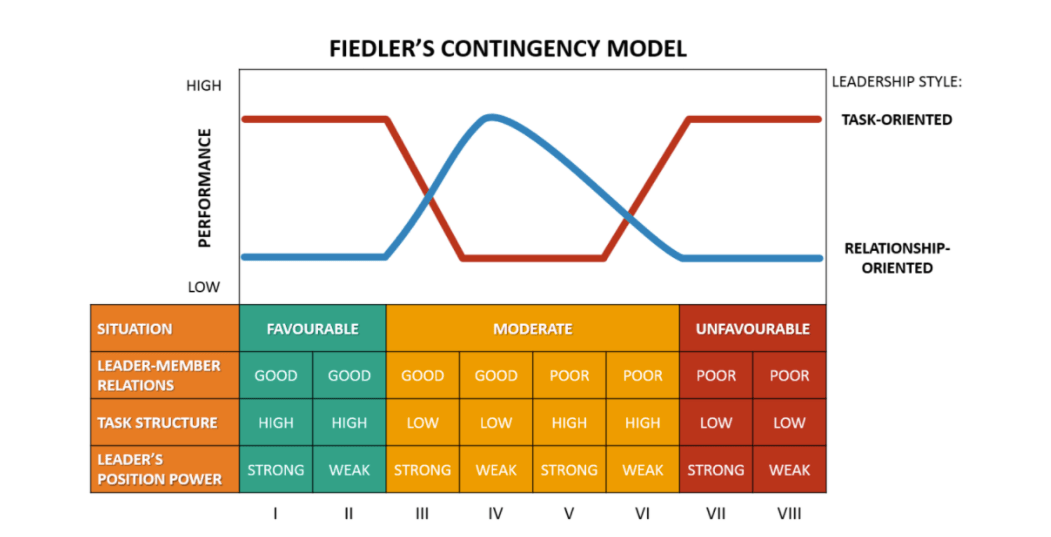
The above suggests that a task-orientated leader drives higher team performance when the situation is both highly favorable or highly unfavorable.
Relationship-orientated leaders enable the team to perform best when the situation is more moderate.
Unlike other theories, Fiedler believes the leadership style is static and cannot adapt to the situation. His advice is that the situation should be changed to meet the leader’s style, or the leader should be changed to meet the situation.
7. Situational leadership theory
Situational leadership theory believes that the most effective leaders need to adapt their leadership style to the situation they find themselves in.
Unlike contingency theory, it does believe leaders can flex their approach to leadership.
By recognizing the need to adapt their style, leaders have a much greater chance of influencing others than they would if they ignored this.
In this model, academic theorists Hersey and Blanchard categorized followers against 2 factors. They were task readiness and psychological readiness.
Task readiness was an indicator of competence — the person’s ability to do the job asked. Psychological readiness indicated their level of motivation to do the job.
Followers were categorized as:
- D1: low competence but high motivation
- D2: low competence and low motivation
- D3: high competence but low motivation
- D4: high competence and high motivation
Depending on the follower category, leaders should adopt one of 4 styles: directing, coaching, supporting, or delegating.
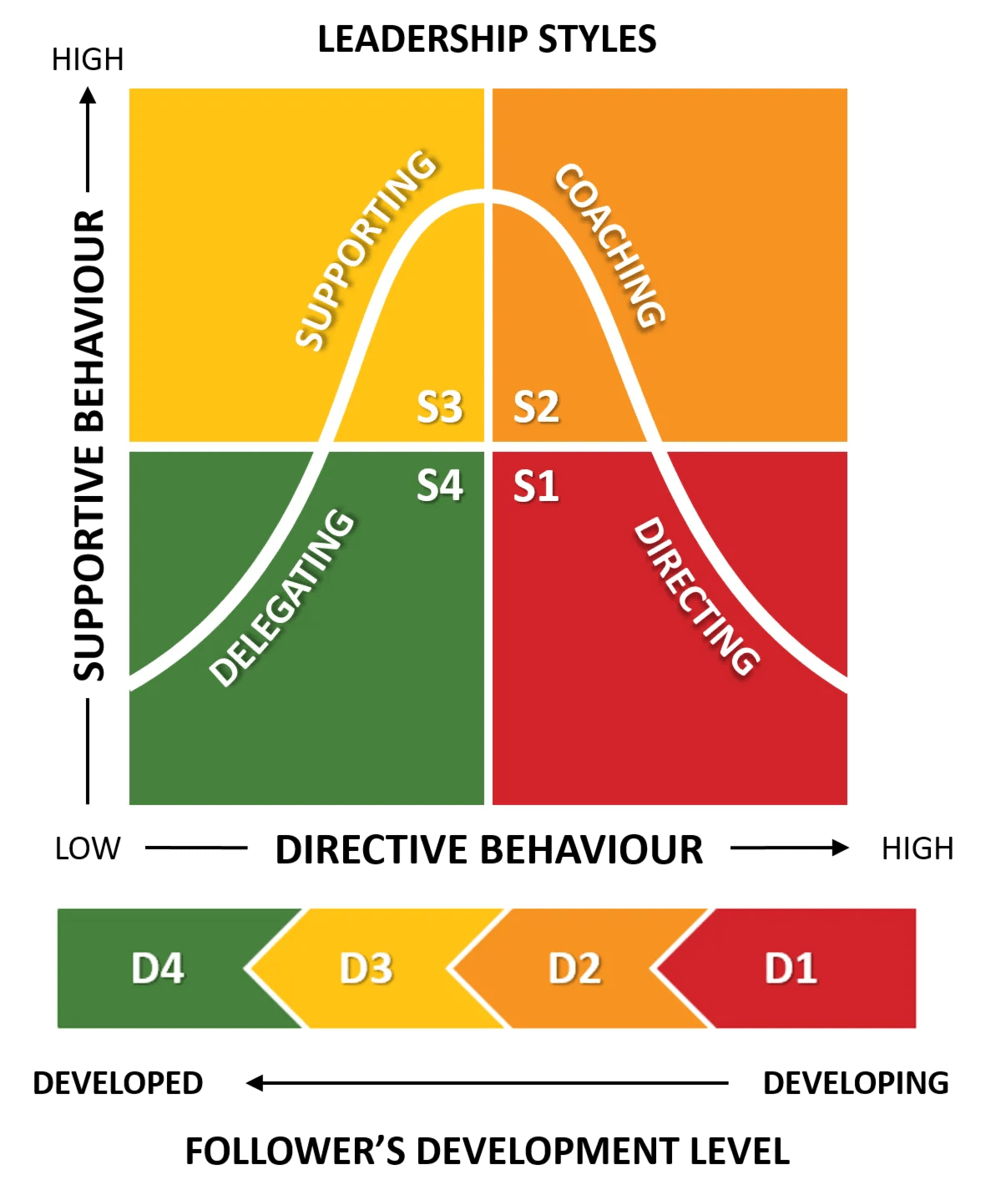
8. Participative theory
Participative leadership isn’t common in large, corporate businesses. This theory centers on the notion that the leader is more of a facilitator.
Sometimes called democratic leadership, a key characteristic is that employees play an active role at all levels of decision-making.
The leader’s role is to collect input from the group and synthesize it to reach a decision. The final decision still rests with the leader, but the thoughts of others heavily influence it.
Participative leadership may be more common in innovation-led companies or start-ups with minimal organizational hierarchy.
However, Microsoft is also famous for this leadership approach.
Bill Gates delegated decision-making down to individual departments and built a strong culture of transparency, encouraging information and knowledge sharing between all employees.
How to choose the right leadership theory for you
If you’re interested in improving your leadership skills, you probably feel less affinity for theories that believe leaders are born, not made.
And, even some supporters of the great man theory would argue that inherent skills need nurturing before you can see their full benefits.
So, how do we translate theories into practice?
Understanding leadership theories is the first step in developing a leadership style that feels authentic and works for the organization and team we’re in.
Leadership styles are the observable behaviors that we adopt as leaders to motivate our teams to take action toward our vision.
Most leadership theories believe leadership styles fall somewhere on the spectrum between task-orientated — or transactional — leadership and relationship-orientated — or transformational — leadership.
Based on that assumption, here are some common leadership styles:
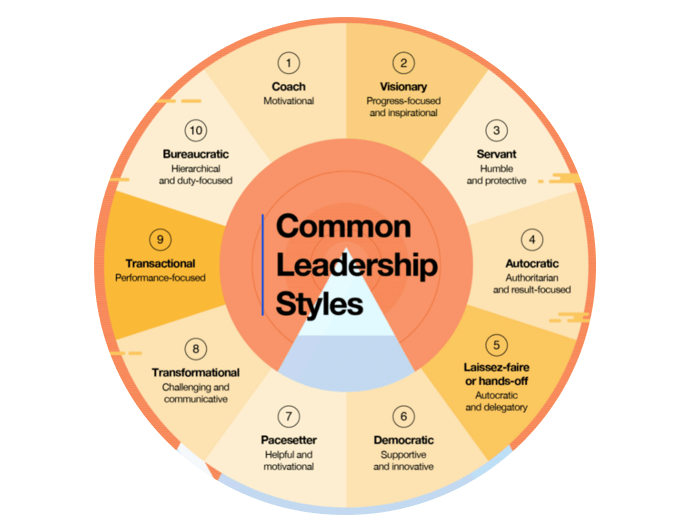
There are several different ways to lead.
From results-focused autocratic leadership to a more coaching style, choosing a leadership style needs to balance personal preference and what the situation requires.
How to adopt a leadership style
Now that we understand leadership theories and styles, how do we go about putting into practice our desired leadership style?
First, look over the leadership styles above. Do the descriptions match the type of leader you want to be or feel that you have to be, based on your current situation? Do you have a particular affinity for one?
What are the typical characteristics of that style?
Next, assess your current leadership ability and organizational culture.
It’s going to be much harder to adopt a visionary leadership style when your preference is to be quieter and more humble. Democratic leaders may feel less comfortable — and have to work harder — in more bureaucratic organizations.
Once you’ve identified your current skills and natural preferences, decide on the leadership style you’d like to adopt. How can you build the required characteristics for that style?
Developing your skills may come from formal or informal training, or you might experiment with different approaches to see whether they are more or less successful.
This is also a good time to look for a mentor. If there’s someone you know who leads in the style you’d like to adopt, seek them out and ask them for help.
Observe what makes them good at what they do or speak to their team to find out what it is that makes them a good leader. Try and emulate those things with your own team.
As you’re experimenting with developing your leadership style, it’s important to seek feedback on your approach.
Check in with your team about how they perceive your leadership and ask for information on things they’d like to be different. It’s worth doing this with your manager and other stakeholders too.
Finally, be authentic.
While you can experiment with different leadership styles, don’t ignore your natural preferences. There are many different types of successful leaders. Trying to be something you’re not over long periods can be stressful and is usually doomed to fail.
How to flex leadership style
There will be times that you need to flex your approach despite your desire to remain authentic and honor your specific leadership style.
This is often due to a change in an internal or external factor that causes a temporary crisis environment.
For example, say you usually lead your team in a democratic manner. Every team member’s contribution is valued equally, and you are more concerned with inclusion, innovation, and collaboration than deadlines.
However, something changes within the business that requires your team to rapidly create a product to match an emerging business-critical requirement.
In that circumstance, you’ll need to flex your leadership style to a more transactional or performance-driven approach to get the job done quickly and successfully.
Neither style is inherently more correct, and both may be appropriate for the circumstance you’re in.
So, how do you flex your style when things change?
First, assess what’s required of you in the new situation and how much of a gap there is between what’s needed and your preferred style and skill set.
Decide what you’re prepared to compromise about your preferred way of leading.
Authentic leadership is important and, if what’s being asked of you is too far away from the type of leader you want to be, it might be time to channel Fred Fiedler and look for another situation.
Once you know what you want to change, seek out others with the required style. Watch how they work with their team to get things done and what effect that has. Try it out on your team and monitor its effectiveness.
Seek feedback about how well your adopted approach is working and continue to build your skills. Reflect and adapt further over time.
How monday.com supports different leadership theories
Whatever your leadership preference, monday.com can help you get the most from your team.
You can use our feedback tracking template to collect feedback from your employees, managers, and stakeholders about your leadership style and how you can get more from your team.
This information can be invaluable in identifying your preferences and any skills gaps.
Whether your natural style is task-orientated, relationship-orientated, or somewhere in between, monday.com has the tools and templates you need.
Plus, if you have to flex your leadership style to a new situation, monday.com can lend a helping hand.
If you’re naturally task-orientated — or having to flex to that style — monday.com makes it simple to track progress with 8 fully customizable views, including Kanban, Gantt, and timeline.
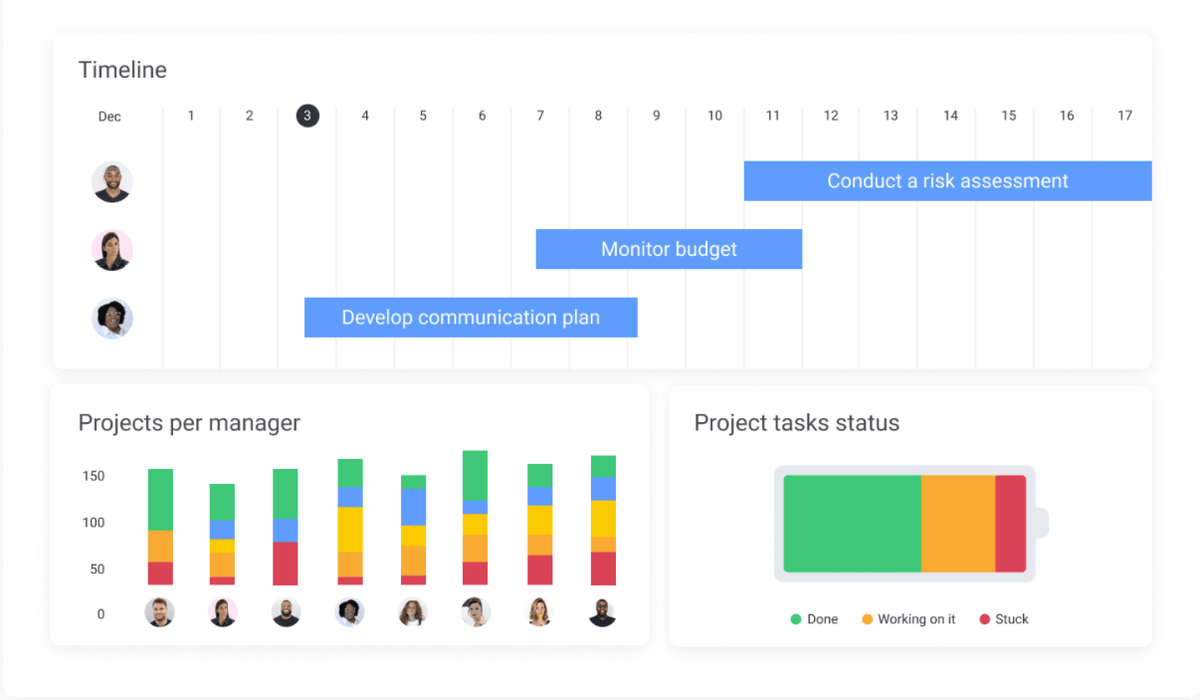
You can also boost productivity through our 1,000s of automation recipes, which means mundane, repetitive tasks can be eliminated from your workflow.
Our extensive reporting functionality is ideal for leaders who prefer data-driven decision-making over intuition.
If you’re more relationship-orientated, building team collaboration and effective communication are probably of high importance.
monday.com makes collaboration simple. Working in our shared digital platform, you can easily view, share, and annotate documents, plus @tag your colleagues to receive input on something you’re working on.

Effective communication is easy with the ability to communicate in-platform or via integration with tools your team may already use.
It’s also easy to delegate work. Our colorful and intuitive boards and drag-and-drop functionality mean it’s easy to assign work to your team and create workflows that work for you.
Understanding leadership theories builds flexibility
In this article, we’ve looked at the 8 main leadership theories. Leadership theories are academic models developed to help us make sense of the different ways to approach leadership.
Our leadership style is the behaviors we adopt when we put leadership theories into practice.
We all have a natural preference for leading in a certain way, and understanding that preference can help us acknowledge when we might need to flex our leadership style.
We can also learn more about how we lead through feedback from our team. Why not build on your understanding today with our helpful feedback tracker?


